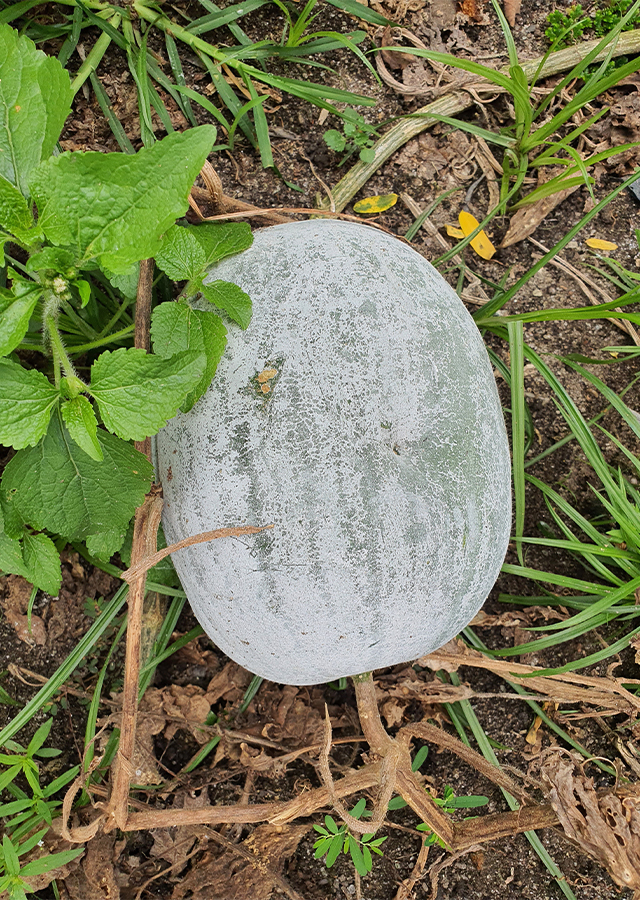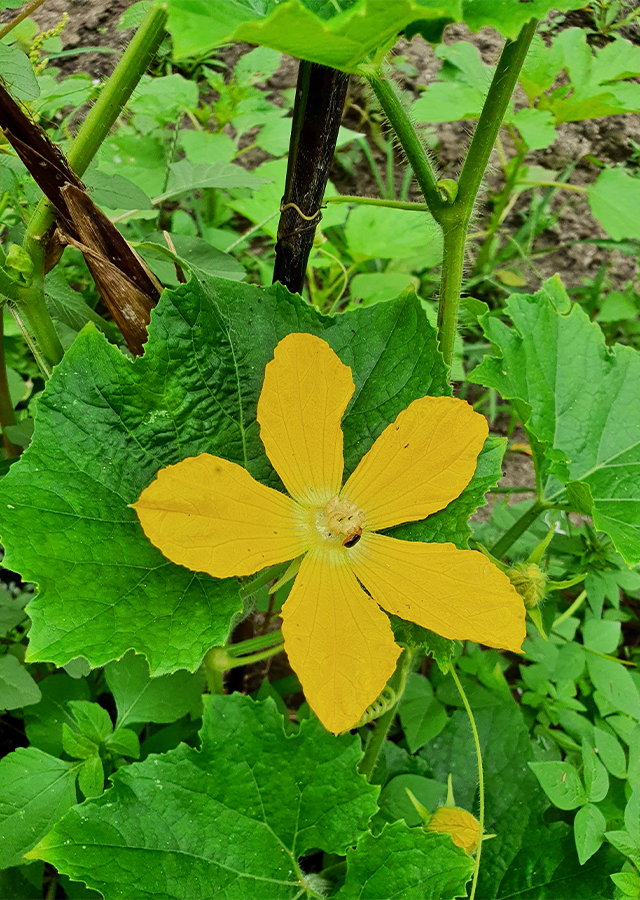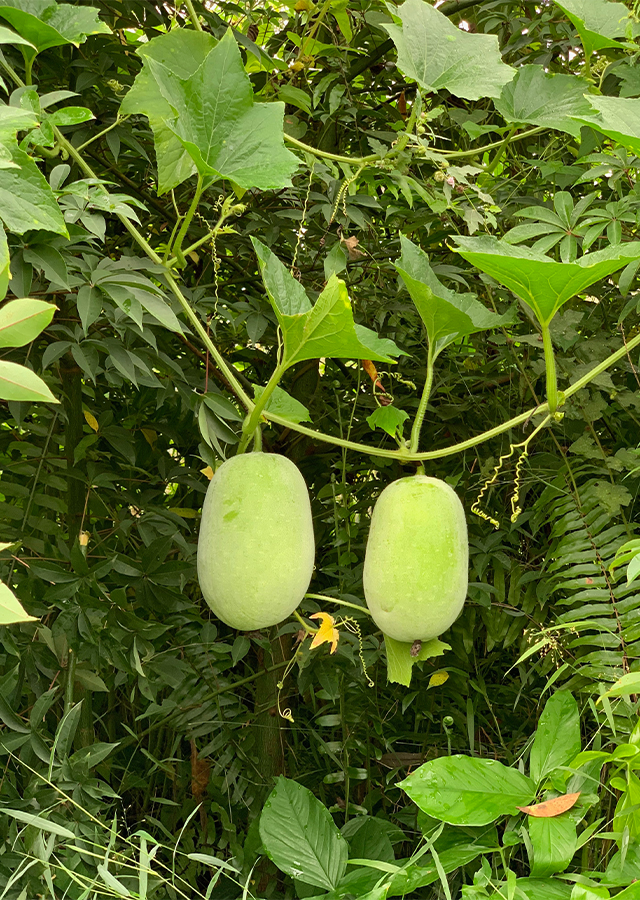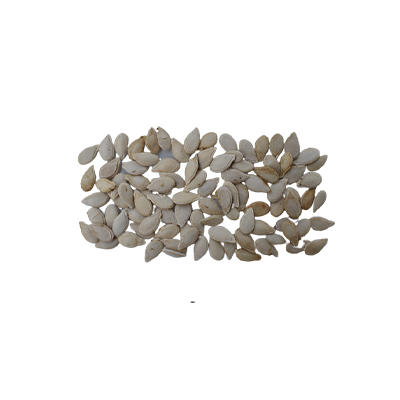Winter melon
Benincasa hispida (Thunb.) Cogn.
Cucurbitaceae
Location in our garden
Vegetable



Synonym
Benincasa cerifera Savi
Benincasa cylindrica Ser.
Benincasa pruriens (Parkinson) W.J.de Wilde & Duyfjes
Habitus
Climbers. An annual, hispid, robust and monoecious plant, growing up to 6 m
Part Used
Seeds
Fruit
Roots
Growing Requirements
Full Sunshine
Drought Resistant
Habitat
Terrestrial
Overview
Winter melon is originated from South Asia and South-East Asia, now it is widely cultivated throughout Asia, the Americas, Europe and Australia. This herb is cultivated in India and China as a vegetable. It has been used as a food and medicine for thousands of years. It was first documented in the Tang Material Medica. it is also called a "wax ground" because the green skin gets coated with a waxy material when it matures. It has little to recommend it as an ornamental.
Vernacular Names
Tung gwa (Chinese), Petha (India), Satou yashi (Japanese), Fak (Thailand), Kyauk-hpayon (Burmese), Bí dao (Vietanamese), Dong A (Korean).
Agroecology
The plant grows in warm tropical and subtropical climates. It thrives in light, friable and well-drained soil. It has a long shelf life. It needs a hot climate and takes 150 days to mature. It grows best in warm weather with maximum sunshine. Winter melon is found during the cold season.
Morphology
- Roots - tap and fibrous.
- Stems - thick, furrowed and clumsily hairy stem can grow up to 1-2 m. (3-6 ft.)
- Leaves - rounded or kidney-shaped leaves with 5 to 7 lobed and heart-shaped at the base with the diameter of leaves 10 to 25 cm.
- Flowers - monoecious, large, yellow color with hairy bell-shaped calyx tube, flowering during July-September.
- Fruits - green with chalky white wax, ovoid or ellipsoid, length 25-40 cm, weighs up to 30 pounds, thin skin along with juicy and sweet interior flesh which is usually white with flat, ovate-elliptic. The fruits may reach lengths of four feet like cucumber and sweet taste, 96% water.
- Seeds - ovate-elliptic, thin, ridged and yellowish-brown.
Cultivation
- Generative propagation by seeds.
- Germination should take place within 2 weeks.
- Plant out after about 14-21 days of growth.
Chemical Constituents
Amino acid, flavonoids, phenolic acid, glycoside, essential oils, saponins, carotene, β-sitosterol, uronic acid, linoleic acid, oleic, isovanillin, sterols, triterpene, alkaloids.
Traditional Medicinal Uses
- Roots: used in the treatment of gonorrhoea, demulcent, salve. Facilitates pus drainage.
- Fruit: to prevent or stop bleeding. the fruit appears to have a cancer-fighting effect, eliminates free radicals, cancer and arthritis, prevent flu and cold, reduce the chances of stroke, prevents migraines, Eye and heart health, diabetes. It is used to treat the health ailments such as gastrointestinal problems, dyspepsia, and asthma, burning sensation, heart diseases, cough, ulcers, urinary diseases, gastrointestinal problems, skin softening and moisturizing and cooling purposes.
- Seeds: anthelmintic, anti-inflammatory, demulcent, diuretic, expectorant, febrifuge, laxative and tonic.
- A decoction of the seed is used internally in the treatment of vaginal discharges and coughs. In combination with Rheum palmatum, it is used to treat intestinal abscesses.
- In Ayurvedic medicine, the seed is used in the treatment of coughs, fevers, excessive thirst and to expel tapeworms. The oil from the seed is also used as an anthelmintic.
- In the Philippines fresh fruit is made into syrup and used for disorders of the respiratory tract.
Part Used
Reference Sources
- Chevallier, A. (2016). Encyclopedia of Herbal Medicine. DK Publishing, New York. page 177. 19-01-2021.
- Emery, C. (2019). The Encyclopedia of Country Living, 50th Anniversary. Sasquatch Books, America. Edition page 347. 19-01-2021.
- Lim, T.K. (2012). Edible Medicinal and Non -Medicinal Plants, Fruits. Vol. 2: 167-178.
- Fern, Ken. (2019). Useful Tropical Plants Database. Winter melon. Benincasa hispida. http://tropical.theferns.info/viewtropical.php?id=Benincasa+hispida. 19-01-2021.
- StuartXchange. (2017). Philippine Medicinal Plants. Kondol. http://www.stuartxchange.com/Kondol.html. 19-01-2021.



